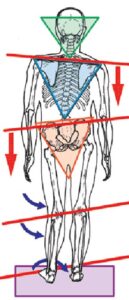Lower back pain; the problem with solving the problem.
Lower back pain is something most of us will likely experience on one or multiple occasions. The problem is that in this country, we spend billions on treatments that are supposed to work, yet they do not. Some of these treatments, such as facet injections which are touted by the medical community for chronic lower back pain and sciatica have low success rates, high prices and can be dangerous as we saw in the news this past year. Other treatments such as physical therapy sometimes work, as well as chiropractic manipulation.
The problem remains that these methods sometimes work. Sometimes is not good enough when your insurance has limited coverage or the cost hits your high deductible first and then your insurance carrier directs care so you find yourself still in pain looking for a solution.
Perhaps the problem is the perspective the healthcare community has on lower back problems is the problem. As is the norm, there are treatments galore, but the results are often so expensive and unreliable, picking the right provider is nothing more than a crap shoot.
Although all healthcare providers perform what may appear to be a thorough evaluation and history, not all evaluations are created equal. Most evaluations for lower back pain with ranges of motion and static orthopedic tests are old school, and not very effective especially if someone who is in a great deal of pain, since the patient may not even tolerate these tests. Somehow, the MRI had become the gold standard for evaluating lower back problems, however, it has been shown that many people have disc problems and degenerative processes in the lower back without any symptoms, which is why these tests should be avoided unless a treatment plan has failed to solve a problem, which incidentally seems to be common.
We need to look at lower back pain and the patients who experience it differently.
A few years back, Dr. Sarno made news with his idea that back pain was all in your head. He received quite a bit of media coverage for his outlandish views, especially since he was affiliated with a major hospital system and was in the department of rehab. Were his findings appropriate? If you read the book, Cheating Mother Nature, what you need to know to beat chronic pain, you will find that while he makes some good arguments, his basic theory is flawed because we are mechanical beings, with problems that develop mechanically, and he totally ignores that.
A different point of view on this from Dr. William Charschan, the author of this book says we need to look at the body, and its mechanisms, rather than the pain which is merely a side effect of mechanical malfunction in the body. Since pain is a symptom, and a faulty mechanism is most often the cause, doesn’t it make sense to evaluate the entire body to understand the mechanism for the pain?
Possible causes of lower back pain often ignored may include:
1. Foot problems and gait asymmetry. This is one of the most common reasons for lower back pain often ignored by many health care practitioners that treat the problem. If not addressed with shoe inserts (orthotics) or by other means, the problem will never be properly addressed and can never resolve. The reason is asymmetry causes un leveling of the hips and distortion of the pelvis. That alone will distort the sacroiliac joints (pelvic joints) resulting in pain.
2. Secondary problems in the upper body and rib cage. If the upper body and rib cage is distorted, and the muscles in the lower body do not allow for proper motion, having the upper body joints locked will strain the lower back joints when sitting, standing and bending. It does not take much additional force to sprain lower back joints when this occurs.
3. Pelvic torsion – often a result of the gait issues in the first part of the article. If this is sustained for a while, the myofascial (connective tissues surrounding the muscles) will lock the pelvis in this distorted posture, resulting in feeling kinked up in the morning, many joints popping throughout the body and a marked loss of flexibility.
4. Problems or malfunctions in the shoulder girdle. This will cause recruitment into the surrounding areas of the mid back, causing many of the problems as discussed above. If chronic, the joint capsules in the shoulders can get very tight, become painful and cause pain in the shoulder itself, or in the worst case, cause a frozen shoulder.
When you consider these possibilities, we need to evaluate people who have back pain with our focus on how their body works, rather than treating their back pain. We need to correct the malfunctions that create the back pain to resolve or significantly improve the condition.
Many newer doctors are now using the idea of active evaluation and use treat – test – treat which has proven to be scientifically valid as well as reliable as a way to figure out why the person is in pain. There are a number of ways to evaluate this way and the technology and thought processes on how to do it are still in its infancy. Having this type of evaluation assures that the practitioner will not just be throwing techniques and treatments at a painful problem, but will test each intervention to see if it reaches the desired result on a given visit. The practitioner then builds on this from visit to visit to a usually successful conclusion.
Treatment methods employed to help result in back pain resolution or relief include.
1. Manipulation by a trained chiropractor. Assures normal joint motion and alignment is restored.
2. Myofascial release, Active Release Treatment ™ or other style of myofascial treatment including Graston, a well known method of instrument assisted soft tissue treatment.
3. Exercises to assure the area involved will be retrained.
4. Orthotics, custom or off the shelf when medically indicated.
Read Cheating Mother Nature, available through Amazon.com and other major booksellers
